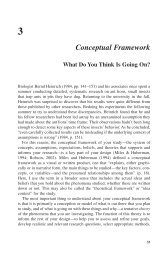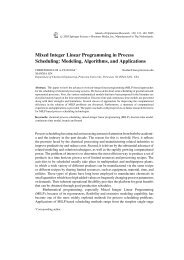R7.1 Polymerization
R7.1 Polymerization
R7.1 Polymerization
Create successful ePaper yourself
Turn your PDF publications into a flip-book with our unique Google optimized e-Paper software.
Termination by<br />
combination<br />
375<br />
Chap.<br />
Figure <strong>R7.1</strong>-5 compares the molecular weight distribution for poly(hexamethylene<br />
adipamide) calculated from Flory’s most probable distribution6<br />
[Equation<br />
(<strong>R7.1</strong>-35)] for a conversion of 99% with the experimental values obtained<br />
by fractionation. One observes that the comparison is reasonably favorable.<br />
For termination by combination, the mole fraction of polymers with j<br />
repeating units is<br />
while the corresponding weight fraction is<br />
where p is given by Equation (<strong>R7.1</strong>-22) [i.e., p = B].<br />
7.1.5 Anionic <strong>Polymerization</strong><br />
(<strong>R7.1</strong>-36)<br />
(<strong>R7.1</strong>-37)<br />
To illustrate the development of the growth of live polymer chains with time,<br />
we will use anionic polymerization. In anionic polymerization, initiation takes<br />
place by the addition of an anion, which is formed by dissociation of strong<br />
bases such as hydroxides, alkyllithium, or alkoxides that react with the mono-<br />
mer to form an active center, . The dissociation of the initiator is very rapid<br />
and essentially at equilibrium. The propagation proceeds by the addition of<br />
monomer units to the end of the chain with the negative charge. Because the<br />
live ends of the polymer are negatively charged, termination can occur only by<br />
charge transfer to either the monomer or the solvent or by the addition of a<br />
6<br />
W j × 10 4<br />
P. J. Flory,<br />
1953).<br />
35<br />
30<br />
25<br />
20<br />
15<br />
10<br />
5<br />
0<br />
0 100<br />
MOL.WT.<br />
10,000 20,000 30,000<br />
p = 0.990<br />
j<br />
40,000 50,000 60,000<br />
200 300 400 500<br />
Figure 7-1 Molecular distribution. [Adapted from G. Tayler, Journal of the<br />
Fogler/Prenhall/F7.7 rev 12/11/97<br />
American Chemical Society, 69, p. 638, 1947. Reprinted by permission.]<br />
y j ( j � 1)<br />
( 1 � p)<br />
2 �<br />
p<br />
w j<br />
1<br />
2<br />
Principles of Polymer Chemistry,<br />
(Ithaca, N.Y.: Cornell University Press,<br />
j 2 �<br />
-- j ( 1 � p)<br />
3 � ( j � 1)p<br />
R 1 �<br />
j 2 �
















